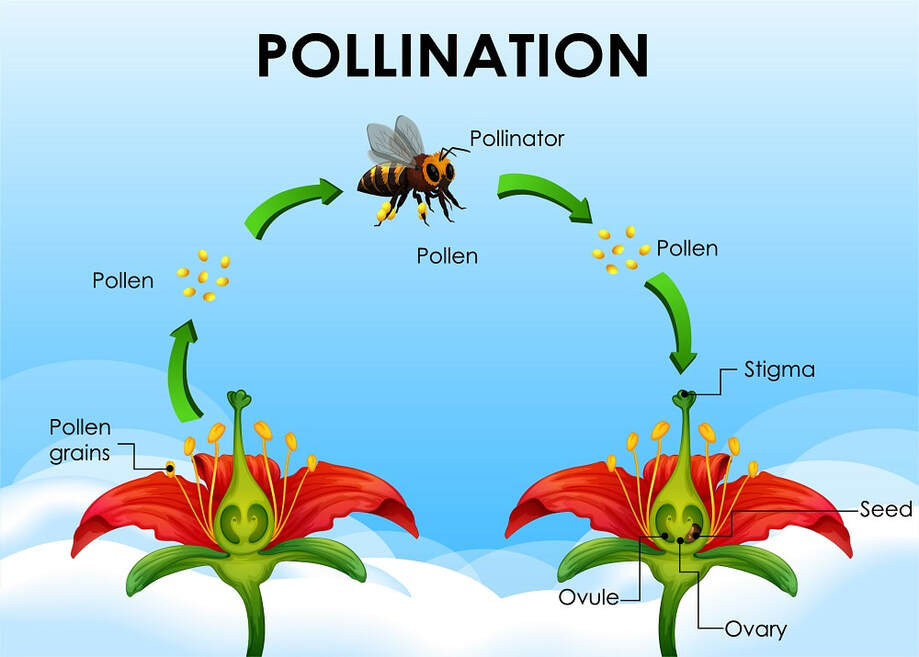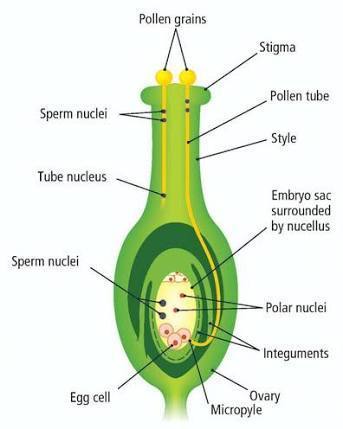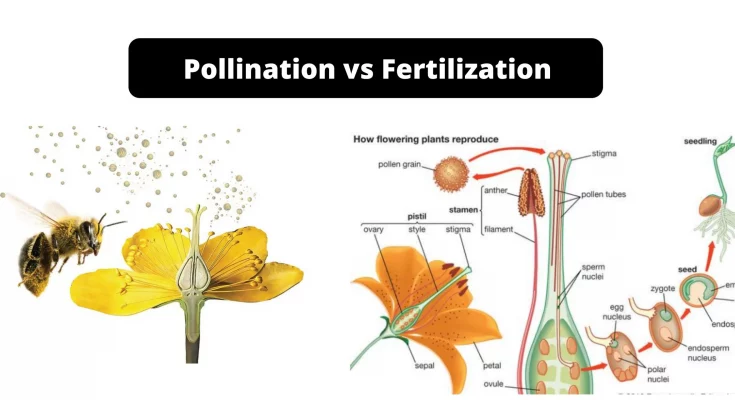During the process of Sexual reproduction in plants, two major events take place-Pollination and Fertilisation. These natural processes play a crucial role in the production of offspring and are essential for the continuation of various plant species. Both Pollination and Fertilisation take place in bisexual flowers involving the male reproductive structure (anther) and the female reproductive structure (stigma). Flowers are therefore considered the reproductive organs of all flowering plants.
Table of Contents
Pollination and Fertilisation
Pollination is a biological process in which pollen grains containing the male genetic material are transferred from the male reproductive organ to the female reproductive organ of a flower. This transfer can occur through various vectors, including wind, birds, honey bees, moths and butterflies. The pollen grains are transported between the anther and the stigma, initiating the process of Pollination. This fascinating mechanism was discovered in the 18th century by the German naturalist Christian Sprengel. There are two main types of Pollination- self-Pollination and cross-Pollination, which are distinguished by the distribution of pollen grains.
After Pollination, the Fertilisation process takes place. Fertilisation involves the fusion of female and male germ cells, resulting in a diploid zygote. This crucial step takes place after the successful Pollination of the ovary. A number of complex processes take place in the zygote that eventually lead to the development of a seed. Flowers play an important role in Fertilisation, as they serve as the reproductive organs of angiosperms.
In plants, Fertilisation occurs through the transfer of male gametes to female reproductive organs by pollinators such as birds, honey bees, butterflies and flower beetles. These agents help transfer the male gametes, resulting in the production of a final product – the seed embryo. The process of Fertilisation in plants can be divided into three types- Chalazogamy, Porogamy and Mesogamy. Each type differs in the penetration of the pollen tube into the ovule and offers unique variations in the Fertilisation process.
Although both Pollination and Fertilisation are essential aspects of plant reproduction, there are significant differences between the two processes. In this article, we will take a closer look at the differences between Pollination and Fertilisation and examine their mechanisms, timing, purpose and gamete involvement.
Difference between Pollination and Fertilisation – Tabular Format
| Differences | Pollination | Fertilisation |
|---|---|---|
| Definition | Transfer of pollen from the male reproductive organ of a flower to the female reproductive organ of the same or a different flower. | Fusion of male and female gametes to form a zygote. |
| Occurrence | Occurs before Fertilisation. | Occurs after successful Pollination. |
| Process | Involves the transfer of pollen from the Anther to the stigma. | Involves the fusion of the male and female gametes. |
| Location | It is an external process. | It is an internal process. |
| Purpose | To transfer pollen from the male reproductive organ to the female reproductive organ. | To form a zygote, which develops into a new individual. |
| Involvement of gametes | Involves only the male gamete (pollen grain). | Involves the fusion of male and female gametes. |
| Pollen Tube | In Pollination, there is no formation of a pollen tube. | A pollen tube is formed for transferring male gametes into an egg cell. |
| Genetic variation | Pollination can lead to genetic variation if the pollen is from a different plant. | Fertilisation always leads to genetic variation as it involves the fusion of different gametes. |
| Types | Can be self-Pollination or cross-Pollination. | Can be internal or external. |
| Organisms | Pollination occurs only in flowering plants. | Fertilisation is followed by almost every living being present on the planet Earth, including plants, animals, birds, insects, humans, etc. |
| Mechanisms | Pollination can occur through various mechanisms such as wind, water, or animals. | Fertilisation occurs through the fusion of gametes. |
| Significance | Pollination is a necessary step for Fertilisation to occur. | Fertilisation is a critical step in sexual reproduction as it leads to the formation of a zygote. |
| Diagram | (Diagram illustrating the processes of Pollination and Fertilisation) | – |
Also Check – “Pollination is Prerequisite for Fertilization in Flowering Plants” Explain
13 Difference between Pollination and Fertilisation – Explained in details
1. Difference between Pollination and Fertilisation in terms of Definition
Pollination- Pollination is the transfer of pollen from the male reproductive organ (anther) of a flower to the female reproductive organ (stigma) of the same or another flower. It is the first step in the sexual reproduction of flowering plants.
Fertilisation- During Fertilisation, the male and female gametes fuse to form a zygote. The male gamete is present in the pollen grain, while the female gamete is present in the ovule.
2. Difference between Pollination and Fertilisation in terms of Occurrence
Pollination- Pollination occurs before Fertilisation. It is the process by which the pollen reaches the stigma and the male and female gametes can come into contact with each other.
Fertilisation- Fertilisation takes place after successful Pollination. Once the pollen grain reaches the stigma, it germinates and the pollen tube grows, allowing the male gametes to reach the egg and fuse with the female gamete.
3. Difference between Pollination and Fertilisation in terms of Process
Pollination- Pollination involves the physical transfer of pollen grains from the anther to the stigma. This transfer can occur by various mechanisms such as wind, water or by animals.
Fertilisation- Fertilisation involves the fusion of the male and female gametes. Once the pollen tube reaches the ovule, the male gametes are released and fuse with the female gamete to form a zygote.
4. Difference between Pollination and Fertilisation in terms of Location
Pollination- Pollination is an external process that takes place on the reproductive organs of the flower. The transfer of pollen from the anther to the stigma can take place within the same flower (self-Pollination) or between different flowers of the same species (cross-Pollination).
Fertilisation- Fertilisation is an internal process that takes place within the reproductive structures of the plant. It takes place in the ovary where the female gamete is located.
5. Difference between Pollination and Fertilisation in terms of Purpose
Pollination- The main purpose of Pollination is to transfer pollen from the male reproductive organ to the female reproductive organ. It facilitates the potential union of the gametes.
Fertilisation- The main purpose of Fertilisation is to form a zygote. The fusion of the male and female gametes results in the formation of a diploid zygote, which develops into a new individual or seed.
Also Check – How do Organisms Reproduce
6. Difference between Pollination and Fertilisation in terms of Involvement of the gametes
Pollination- Only the male gamete is involved in Pollination (contained in the pollen grain). The pollen grain carries the male genetic material (sperm).
Fertilisation- During Fertilisation, the male and female gametes fuse. The male gametes released from the pollen grain fuse with the female gamete (egg cell) contained in the ovule.
7. Difference between Pollination and Fertilisation in terms of Pollen tube
Pollination- pollen tube is not formed during Pollination. The pollen grain lands on the stigma and germinates to form a pollen tube at Fertilisation.
Fertilisation- At Fertilisation, a pollen tube is formed to transfer the male gametes from the stigma to the ovule. The pollen tube grows through the style and brings the male gametes to fuse with the female gamete.
Also Check – The Why, What, When, Where, Who, How of Pollination
8. Difference between Pollination and Fertilisation in terms of Genetic variation
Pollination- Pollination can lead to genetic variation if the pollen comes from another plant. Cross-Pollination, where pollen is transferred between different flowers, leads to genetic diversity in the offspring.
Fertilisation- Fertilisation always leads to genetic variation because it involves the fusion of different gametes from different individuals. The combination of genetic material from two parents contributes to diversity in the offspring.
9. Difference between Pollination and Fertilisation in terms of Types
Pollination- Pollination can be either self-Pollination or cross-Pollination. In self-Pollination, the pollen of the stamen fertilises the stigma of the same flower or of another flower of the same plant. Cross-Pollination occurs when the pollen is transferred between flowers of different plants.
Fertilisation- Fertilisation can be internal or external. Internal Fertilisation takes place within the reproductive structures of the organism, as is the case with most plants. External Fertilisation occurs outside the body of the organism, which is often observed in aquatic organisms.
10. Difference between Pollination and Fertilisation in terms of Organisms
Pollination- Pollination occurs exclusively in flowering plants (angiosperms) because they have specialised reproductive structures, including flowers, anthers and stigmas.
Fertilisation- Fertilisation is a fundamental process in the reproduction of various organisms, including plants, animals, birds, insects and humans.
11. Difference between Pollination and Fertilisation in terms of Mechanisms
Pollination- Pollination can occur through various mechanisms, such as wind (wind-pollinated plants), water ( hydrophilous plants) or animals ( zoophilous plants). Animals such as bees, birds, butterflies and other insects help transfer pollen.
Fertilisation- Fertilisation occurs through the fusion of germ cells. It does not depend on external mechanisms but is a biological process that takes place once the male and female gametes are in close proximity.
12. Difference between Pollination and Fertilisation in terms of Significance
Pollination- Pollination is a necessary step for Fertilisation to occur. Without Pollination, i.e. the transfer of pollen to the stigma, Fertilisation cannot take place, which leads to a failure of the reproductive process.
Fertilisation- Fertilisation is a crucial step in sexual reproduction, as it leads to the formation of a zygote, which develops into a new individual or seed. It is essential for the continuation of the species.
13. Difference between Pollination and Fertilisation – Diagram
Pollination- A diagram can illustrate the process of Pollination, depicting the transfer of pollen from the anther to the stigma.

Fertilisation- A diagram illustrating Fertilisation typically shows the growth of a pollen tube, the fusion of male and female gametes, and the formation of a zygote.

Curious Questions on Pollination and Fertilisation
How do plants “choose” their pollinators?
- Plants don’t choose but evolve traits that attract specific pollinators. For instance, flowers that are pollinated by birds might be red and produce lots of nectar.
Can plants reject pollen?
- Yes, plants have mechanisms to reject pollen, especially if it’s from the same plant (self-pollination), which helps to increase genetic diversity.
Do all flowers have both male and female parts?
- No, some plants have separate male and female flowers. This is known as dioecy.
What happens if a flower doesn’t get pollinated?
- If a flower isn’t pollinated, it usually won’t produce seeds and, consequently, won’t reproduce.
Why don’t all plants self-pollinate? Isn’t it easier?
- Cross-pollination increases genetic diversity, which is beneficial for the survival and adaptability of the species.
How does the pollen tube “know” where to go?
- The pollen tube grows directionally towards the ovule guided by chemical signals.
Are there any plants that can only be pollinated by a single type of animal?
- Yes, some plants have evolved in tandem with a specific pollinator and can only be pollinated by that species, like the yucca plant and the yucca moth.
Can a flower be pollinated by pollen from a different species of plant?
- Generally, no, as plants have specific compatibility mechanisms, but in rare cases or human-mediated scenarios, hybrids can occur.
What’s the rarest form of pollination?
- Some plants, like the corpse flower, have unique pollination strategies involving mimicking the smell of rotting flesh to attract specific insects.
Why do some plants have brightly coloured flowers?
- Bright colours and patterns are often used to attract pollinators. For example, bees can see ultraviolet patterns on flowers that guide them to the nectar.
Is pollination affected by climate change?
- Yes, changes in climate can affect the timing of flowering and the availability of pollinators, disrupting the pollination process.
How do wind-pollinated plants differ in appearance from insect-pollinated plants?
- Wind-pollinated plants typically have less showy flowers and produce a lot of light pollen, while insect-pollinated flowers are often more colourful and produce sticky or barbed pollen.
Can fertilisation happen without pollination?
- No, fertilisation requires the transfer of pollen to the stigma of a flower, which is the process of pollination.
What would happen if all bees disappeared?
- The disappearance of bees would significantly affect plant pollination, leading to reduced plant reproduction, affecting ecosystems and food sources for many species, including humans.
Frequently asked questions on the difference between Pollination and Fertilisation
What is the main purpose of Pollination and Fertilisation?
Answer – Pollination- The main purpose of Pollination is to transfer pollen from the male reproductive organ to the female reproductive organ, allowing the potential union of gametes.
Fertilisation- The main purpose of Fertilisation is to form a zygote, resulting from the fusion of the male and female gametes.
Which process occurs first, Pollination or Fertilisation?
Answer – Pollination occurs before Fertilisation. Pollination is the transfer of pollen to the stigma, while Fertilisation occurs after successful Pollination.
What is the role of the male and female gametes in Pollination and Fertilisation?
Answer – Pollination- Only the male gamete (contained in the pollen grain) is involved in Pollination. The pollen grain carries the male genetic material.
Fertilisation- During Fertilisation, both the male and female gametes fuse. The male gametes, released from the pollen grain, fuse with the female gamete (egg cell) contained in the ovule.
Also Check – How is the Process of Pollination Different from Fertilization
How is pollen transferred during Pollination?
Answer – Pollen can be transferred during Pollination through various mechanisms, such as wind, water, or animals like bees, birds, butterflies, and other insects.
What happens to the pollen grain after it reaches the stigma during Fertilisation?
Answer – After reaching the stigma, the pollen grain germinates and forms a pollen tube. The pollen tube grows through the style and delivers the male gametes to the ovule for Fertilisation.
Also check – 16 Important Differences between Cross Pollination and Self Pollination
Where does Fertilisation take place within the plant?
Answer – Fertilisation takes place within the reproductive structures of the plant, specifically in the ovary where the female gamete is located.
Can self-Pollination lead to genetic variation? Why or why not?
Answer – Self-Pollination generally does not lead to significant genetic variation as the pollen from the stamen fertilises the stigma of the same flower or another flower on the same plant. It involves the fusion of genetically similar gametes.
Also Check – Agents of Cross-Pollination
What is the significance of the pollen tube in the Fertilisation process?
Answer – The pollen tube plays a crucial role in Fertilisation as it transports the male gametes from the stigma to the ovule. It ensures the successful delivery and fusion of the male and female gametes.
In which types of organisms does Pollination occur?
Answer – Pollination occurs exclusively in flowering plants (angiosperms) as they possess specialised reproductive structures like flowers, anthers, and stigmas.
Explain the difference between internal and external Fertilisation.
Answer – Internal Fertilisation occurs within the reproductive structures of the organism. This is observed in most plants, where the male and female gametes fuse inside the ovule.
External Fertilisation occurs outside the body of the organism and is often observed in aquatic organisms. The fusion of gametes happens in the external environment, such as in water.
How does Pollination occur in wind-pollinated plants?
Answer – In wind-pollinated plants, the pollen grains are light and abundant. They are released into the air and carried by the wind to reach the stigmas of other flowers. This mechanism allows for Pollination without the need for animal vectors.
Which factors contribute to genetic variation during Fertilisation?
Answer – Genetic variation during Fertilisation is contributed by the fusion of gametes from different individuals. Each parent contributes a unique set of genetic material, resulting in genetic diversity in the offspring.
Also Check – 9 Important Differences between Sexual and Asexual Reproduction
Describe the mechanisms of Pollination through animals.
Answer – Animals, such as bees, birds, butterflies, and other insects, play a crucial role in Pollination. They visit flowers to collect nectar or pollen, and in the process, pollen grains get attached to their bodies. When they move to another flower, the pollen grains are transferred, allowing Pollination to occur.
Why is Pollination necessary for successful Fertilisation?
Answer – Pollination is necessary for successful Fertilisation as it brings the male and female gametes in close proximity. Without Pollination, i.e., the transfer of pollen to the stigma, Fertilisation cannot occur, leading to a failure in the reproductive process.
What are the consequences of failed Fertilisation in plants?
Failed Fertilisation in plants results in the inability to form a zygote and develop seeds. This can lead to a failure in plant reproduction, reduced genetic diversity, and a potential decline in population size.

